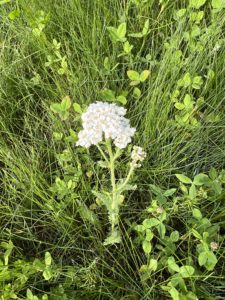Table of Contents
Herb–Yarrow
(Achillea milleforium)
Alias names for Yarrow: (Note: what does the name of yarrow mean here.) Achillea millefolium, Herba militaris, yarrow milfoil, nosebleed, soldier’s woundwort. Yarrow is in the Aster Family. Chinese Names for Yarrow: Ya Luo
Pictures of Yarrow: A healing herb used widely by herbalists.

Yarrow growing in the wild at Elk Meadow Farm.
References for Yarrow pictures: Elk Meadow Farm, Deary, Idaho
About Yarrow:
Yarrow has a long history as a wound healer. It is a perennial that grows wild in well-drained soil in full sun in temperate regions around the world in meadows and along roadsides. A native plant growing in Europe, Asia and in North America. Yarrow is closely associated with divination. In China, the stalks are used for consulting the I Ching.
Actions and Uses of Yarrow:
- Anti-Allergenic
- Anticoagulant (after a stroke or heart Attack)
- Anti-inflammatory (chamazulene chemical)
- Antispasmodic (flavonoids component)
- Astringent
- Bitter tonic (useful for weak digestion and colic)
- Diuretic and urinary antiseptic
- Improves venous circulation
- Increases sweating
- Lowers blood pressure
- Mild Sedative
- Mucolytic
- Nervine (Ayurvedic Medicine) usually combined with Tilia or Salvia officinalis)
- Promotes menstruation, eases menstrual pain, reduces heavy bleeding
- Reduces fever (best known herbal remedy for this)
- Stops internal/external bleeding
- Tones varicose veins
Historical Uses of Yarrow and How it Works:
- Abscesses
- Beneficial For Hay Fever
- Bleeding Conditions: Ulcers
- Chicken Pox
- Crohn’s Disease
- Heart-slows the heart rate
- Helpful For Circulatory Disorders
- Helpful For Menstrual Problems
- Hemorrhoids
- Hypertension (High Blood Pressure)
- Indigestion/Heartburn
- Internal Heat Conditions (Colds, Influenza, Measles)
- Pap Smears, Abnormal
- Premenstrual Syndrome
- Recovery From Colds and Flu
- Rheumatism
- Strengthening Bitter Tonic.
- Treats Congestion
- Ulcerative Colitis
- Upset Stomach (Dyspepsia)
- Urinary Tract Infections (leukorrhea)
- Used For Healing Wounds for Centuries
Actions of Yarrow:
Yarrow is responsible for general effects on the whole body, lungs and liver. Yarrow is a neutral, bitter, spicy herb.
Parts of Yarrow Plant Used:
- Flowers, cut in summer and dried
- Leaves (make into a poultice and apply to wounds, scrapes, cuts, bruises)
Essential Oil, Infusions, Liquid extracts, Lotions and Tinctures are made from the different plant parts.
Chemical Constituents of Yarrow:
- Achilleine (stops bleeding) a bitter glycol alkaloid
- Alkamides (also found in echinacea) act as an anti-inflammatory
- Azuline (anti-inflammatory)
- Borneol
- Cineole
- Coumarins
- Cyanidin-influences the vagus nerve to slow the heart rate
- Flavonoids
- Isoartemesia ketone
- Lactones
- Polyacetylenes
- Salicylic Acid (anti-inflammatory)
- Saponins
- Sesquiterpene lactones
- Sterols
- Tannins
- Thujone
- Triterpenes
- Volatile oils (Linalool, camphor, sabinene, chamazulene)
Contraindications, safety issues, concerns, harmful drug interactions and allergy precautions for Yarrow:
- Do not take during pregnancy.
- Prolonged use may cause photosensitization and allergic rashes.
Other Notes for Yarrow:
- All kinds of digestive bitters drinks have been made from yarrow.
Cultivation of Yarrow:
Propagation is by division and cuttings but it also spreads via seed and roots and grows up to 3 feet tall. Prone to mildew in hot, dry conditions. The white flower version is the medicinal herb but there are many colors of ornamental yarrow which do not contain the medicinal chemicals in high enough volume to be used as a medicine.
Yarrow is a beneficial insect attractant plant (ladybugs and parasitic wasps). It is fairly invasive.
Helpful Links and References for Yarrow:
Wildflowers.org Achillea milleforium: https://www.wildflower.org/plants/result.php?id_plant=acmi2